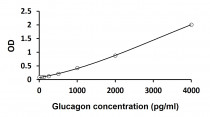Glucagon ELISA Kit
CAT.NO. : ARG81293
US$ Please choose
US$ Please choose
Size:
Trail, Bulk size or Custom requests Please contact us
概述
| 产品描述 | ARG81293 Glucagon ELISA Kit is an Enzyme Immunoassay kit for the quantification of Glucagon in serum, plasma or cell culture supernatants. |
|---|---|
| 反应物种 | Hu, Ms, Rat, Pig |
| 应用 | ELISA |
| 特异性 | No significant cross-reactivity or interference with the factors below was observed:Glucentin-Related Polypeptide (aa 21-50), Glucagon-Like Peptide 1 (aa 92-128) and Glucagon-Like Peptide 2 (aa 146-178). |
| 靶点名称 | Glucagon |
| 偶联标记 | HRP |
| 偶联标记说明 | Substrate: TMB and read at 450 nm. |
| 灵敏度 | 30 pg/ml |
| 样品类型 | Serum, plasma or cell culture supernatants. |
| 标准范围 | 62.5 - 4000 pg/ml |
| 样本量 | 100 µl |
| 別名 | GLP-1; GLP-2; GLP1; OXY; GLP2; Glucagon; OXM; Incretin hormone; GRPP |
应用说明
| 检测时间 | ~ 5 hours |
|---|
属性
| 形式 | 96 well |
|---|---|
| 存放说明 | Store the kit at 2-8°C. Keep microplate wells sealed in a dry bag with desiccants. Do not expose test reagents to heat, sun or strong light during storage and usage. Please refer to the product user manual for detail temperatures of the components. |
| 注意事项 | For laboratory research only, not for drug, diagnostic or other use. |
生物信息
| 数据库连接 | |
|---|---|
| 基因名称 | GCG |
| 全名 | glucagon |
| 背景介绍 | The protein encoded by this gene is actually a preproprotein that is cleaved into four distinct mature peptides. One of these, glucagon, is a pancreatic hormone that counteracts the glucose-lowering action of insulin by stimulating glycogenolysis and gluconeogenesis. Glucagon is a ligand for a specific G-protein linked receptor whose signalling pathway controls cell proliferation. Two of the other peptides are secreted from gut endocrine cells and promote nutrient absorption through distinct mechanisms. Finally, the fourth peptide is similar to glicentin, an active enteroglucagon. [provided by RefSeq, Jul 2008] |
| 生物功能 | Glucagon plays a key role in glucose metabolism and homeostasis. Regulates blood glucose by increasing gluconeogenesis and decreasing glycolysis. A counterregulatory hormone of insulin, raises plasma glucose levels in response to insulin-induced hypoglycemia. Plays an important role in initiating and maintaining hyperglycemic conditions in diabetes. GLP-1 is a potent stimulator of glucose-dependent insulin release. Play important roles on gastric motility and the suppression of plasma glucagon levels. May be involved in the suppression of satiety and stimulation of glucose disposal in peripheral tissues, independent of the actions of insulin. Have growth-promoting activities on intestinal epithelium. May also regulate the hypothalamic pituitary axis (HPA) via effects on LH, TSH, CRH, oxytocin, and vasopressin secretion. Increases islet mass through stimulation of islet neogenesis and pancreatic beta cell proliferation. Inhibits beta cell apoptosis. GLP-2 stimulates intestinal growth and up-regulates villus height in the small intestine, concomitant with increased crypt cell proliferation and decreased enterocyte apoptosis. The gastrointestinal tract, from the stomach to the colon is the principal target for GLP-2 action. Plays a key role in nutrient homeostasis, enhancing nutrient assimilation through enhanced gastrointestinal function, as well as increasing nutrient disposal. Stimulates intestinal glucose transport and decreases mucosal permeability. Oxyntomodulin significantly reduces food intake. Inhibits gastric emptying in humans. Suppression of gastric emptying may lead to increased gastric distension, which may contribute to satiety by causing a sensation of fullness. Glicentin may modulate gastric acid secretion and the gastro-pyloro-duodenal activity. May play an important role in intestinal mucosal growth in the early period of life. [UniProt] |
| 产品亮点 | Related products: Glucagon antibodies; Glucagon ELISA Kits; New ELISA data calculation tool: Simplify the ELISA analysis by GainData |
| 翻译后修饰 | Proglucagon is post-translationally processed in a tissue-specific manner in pancreatic A cells and intestinal L cells. In pancreatic A cells, the major bioactive hormone is glucagon cleaved by PCSK2/PC2. In the intestinal L cells PCSK1/PC1 liberates GLP-1, GLP-2, glicentin and oxyntomodulin. GLP-1 is further N-terminally truncated by post-translational processing in the intestinal L cells resulting in GLP-1(7-37) GLP-1-(7-36)amide. The C-terminal amidation is neither important for the metabolism of GLP-1 nor for its effects on the endocrine pancreas. |
 New Products
New Products





















